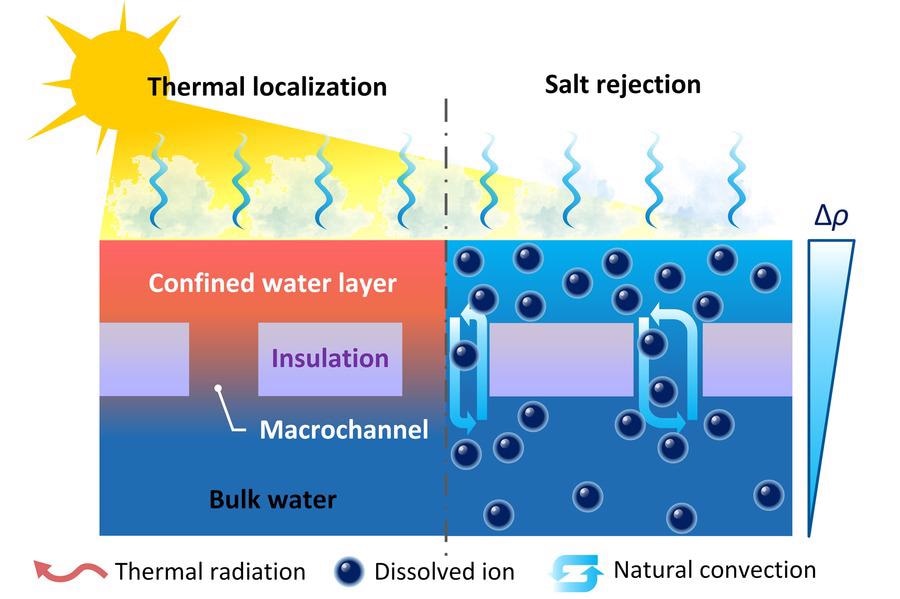MIT researchers have developed a novel low-cost passive solar-evaporation system that demonstrates much promise for wastewater treatment, seawater desalination, medical instrument sterilization and vapor generation.
 Image Credit: Chandler, D., (2022) Solar-powered system offers a route to inexpensive desalination. [online] MIT News | Massachusetts Institute of Technology. Available at: https://news.mit.edu/2022/solar-desalination-system-inexpensive-0214
Image Credit: Chandler, D., (2022) Solar-powered system offers a route to inexpensive desalination. [online] MIT News | Massachusetts Institute of Technology. Available at: https://news.mit.edu/2022/solar-desalination-system-inexpensive-0214
Water scarcity affects many countries, and with global water use rising at more than twice the rate of population growth, certain areas are sure to feel the strain of sustaining reliable water services. Furthermore, many developing countries hit by water scarcity issues also have problems accessing a dependable source of electricity.
These cumulative issues have seen a number of research efforts concentrate on developing effective methods and ways to desalinate and clean up seawater as well as treating waste and brackish water using only solar energy. However, devices can become compromised through the build-up of salt, which causes unwanted fouling and degradation.
To enable highly efficient and reliable solar evaporation, a key bottleneck is to achieve simultaneous thermal localization and salt rejection.
Evelyn Wang, Co-Author and Professor of Mechanical Engineering
“The challenge has been the salt fouling issue, that people haven’t really addressed. So, we see these very attractive performance numbers, but they’re often limited because of longevity. Over time, things will foul,” she adds.
Developing Solar Desalination
The majority of existing solar desalination systems use a ‘wick’ structure to create a system for transporting the water through the device which is prone to clogging or crystallization, making them notoriously difficult to clean.
This led the MIT team to focus on developing a device that is not reliant on a wick-system but instead on a series of confined layers that offer a simple, low-cost approach.
Each layer performs a specific function, one of which absorbs heat from the sun, while another is a thin layer of water that sits atop a perforated material layer that can rest above a reservoir, water tank or pond.
Throughout development, MIT applied careful calculations to their experiments to determine what would be the ideal perforation size of the polyurethane material during testing. With the optimal size set to be 2.5 mm, the team was able to create the perforation holes using readily available waterjets.
The holes facilitate a natural convective circulation which can draw the denser water from the top layer into the reservoir layer, where the salt becomes well-diluted and no longer problematic.
It allows us to achieve high performance and yet also prevent this salt accumulation.
Evelyn Wang, Co-Author and Professor of Mechanical Engineering
Like hot air rises and cold air falls, the high density water at the top interface of the system drives the salty liquid through to the bottom of the layered structure. Subsequently, the evaporated freshwater can be collected on top of a condensing surface.
Transforming Wastewater
The novel thing about this strategy is that as it can work with water of high-saline saturation in varying conditions, it is extremely useful for treating wastewater. Furthermore, other solar-powered methods often use expensive, unconventional materials in their design, whereas the MIT researchers were able to create a system using relatively inexpensive household items.
People say you always need new materials, expensive ones, or complicated structures or wicking structures to do that. And this is, I believe, the first one that does this without wicking structures.
Xiangyu Li, Postdoctoral Associate, MIT
The team also needed to prevent heat loss as this can be a consequence of the saltwater being rejected, so the team used an insulated material for the perforated layer and painted the top solar layer black.
This approach not only offers an effective desalination method but could also signify a turning point in solar evaporation and water desalination if the method can be efficiently scaled up.
The team believes that a device around 1 m2 would only cost in the region of 4-5 USD. This means the device could be made affordable to almost all areas globally and help transform wastewater into a usable resource.
I think a real opportunity is the developing world, I think that is where there's most probable impact near-term, because of the simplicity of the design.
Evelyn Wang, Co-Author and Professor of Mechanical Engineering
References and Further Reading
Chandler, D., (2022) Solar-powered system offers a route to inexpensive desalination. [online] MIT News | Massachusetts Institute of Technology. Available at: https://news.mit.edu/2022/solar-desalination-system-inexpensive-0214
UN-Water. (2022) Scarcity | UN-Water. [online] Available at: https://www.unwater.org/water-facts/scarcity/
Disclaimer: The views expressed here are those of the author expressed in their private capacity and do not necessarily represent the views of AZoM.com Limited T/A AZoNetwork the owner and operator of this website. This disclaimer forms part of the Terms and conditions of use of this website.